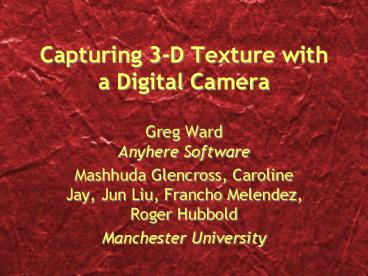Capturing 3D Texture with a Digital Camera - PowerPoint PPT Presentation
1 / 17
Title: Capturing 3D Texture with a Digital Camera
1
Capturing 3-D Texture with a Digital Camera
- Greg WardAnyhere Software
- Mashhuda Glencross, Caroline Jay, Jun Liu,
Francho Melendez, Roger Hubbold - Manchester University
2
Depth Hallucination The Short Story
- Acquire Textured surface model
- From a single view
- Using only a digital camera and a flash.
3
Why Do We Want Depth?
- Classical Texture Mapping
- Images mapped to 2D geometry
- No self-shadowing/silhouette detail
- Real-world textured surfaces
- Visually rich, changes with view and lighting
- Common in nature and the built environment
- Aesthetics / ornamentation
4
Real-World Examples
5
Depth Hallucination Method
- Steps
- Capture flash / No-flash image pair
- Estimate Albedo
- Estimate a shading image
- Calculate depth
- Assumptions
- Diffuse/sky illumination
- Global curvature ignored
- Specular reflectance removed
6
(No Transcript)
7
Albedo Estimation
- Starting with flash / no-flash input pair
- Correct for Ambient lighting using no-flash image
- Correct for vignetting using flash calibration
image - Result Albedo map
If (j) Id (j)
8
Compute Shading Image
9
Depth Estimation from Shading Image
- We formulate a hypothesis about local surface
structure
10
Above/Below Plane Models
- Above plane model
- Below plane model
11
Combined Surface Model
12
Apply at Multiple Scales
13
Simplified Capture w/o Flash
- Histogram Matching
- Needs exemplar model
- Single diffuse-lit photo
- Match histograms
- Create rendering
14
Validation
- First user study
- Rank sequentially presented images
- Photos 3.97
- Relit images 3.22
- Histogram matched 2.98
15
Validation
- Second user study
- Select most plausible surface
- No significant difference in peoples subjective
choices
16
Limitations
- Our method will fail if
- Surface geometry cannot be represented as a
height field - Daylight is heavily biased towards one dominant
direction - Surface contains highly reflective or translucent
materials
17
Conclusion
- Simple method
- Results like photographs
- 75 of participants rated our images more likely
to be photos - Participants unable to decide if renderings of
hallucinated depth or laser-scans more plausible































